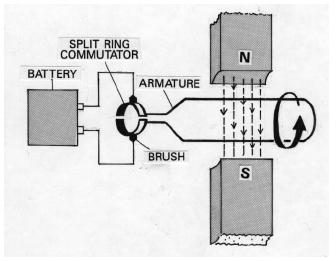Energy comes in many forms. Electric energy can be converted into useful work, or mechanical energy, by machines called electric motors. Electric motors work due to electromagnetic interactions: the interaction of current (the flow of electrons) and a magnetic field.
Problem
Find out how to make a simple electric motor.
Materials
- D battery
- Insulated 22G wire
- 2 large-eyed, long, metal sewing needles (the eyes must be large enough to fit the wire through)
- Modeling clay
- Electrical tape
- Hobby knife
- Small circular magnet
- Thin marker

Procedure
- Starting in the center of the wire, wrap the wire tightly and neatly around the marker 30 times.
- Slide the coil you made off of the marker.
- Wrap each loose end of the wire around the coil a few times to hold it together, then point the wires away from the loop, as shown:

What is this? What is its purpose?
- Ask an adult to use the hobby knife to help you remove the top-half of the wire insulation on each free end of the coil. The exposed wire should be facing the same direction on both sides. Why do you think half of the wire needs to remain insulated?

- Thread each loose end of the wire coil through the large eye of a needle. Try to keep the coil as straight as possible without bending the wire ends.

- Lay the D battery sideways on a flat surface.
- Stick some modeling clay on either side of the battery so it does not roll away.
- Take 2 small balls of modeling clay and cover the sharp ends of the needle.
- Place the needles upright next to the terminals of each battery so that the side of each needle touches one terminal of the battery.

- Use electrical tape to secure the needles to the ends of the battery. Your coil should be hanging above the battery.
- Tape the small magnet to the side of the battery so that it is centered underneath the coil.

- Give your coil a spin. What happens? What happens when you spin the coil in the other direction? What would happen with a bigger magnet? A bigger battery? Thicker wire?
Results
The motor will continue to spin when pushed in
the right direction. The motor will not spin when the initial push is in
the opposite direction.
Why?
The metal, needles, and wire created a closed loop circuit
that can carry current. Current flows from the negative terminal of the
battery, through the circuit, and to the positive terminal of the
battery. Current in a closed loop also creates its own magnetic field,
which you can determine by the “Right Hand Rule.” Making a “thumbs up”
sign with your right hand, the thumb points in the direction of the
current, and the curve of the fingers show which way the magnetic field
is oriented.
In our case, current travels through the coil you created, which is called the armature of the motor. This current induces a magnetic field in the coil, which helps explain why the coil spins.
Magnets
have two poles, north and south. North-south interactions stick
together, and north-north and south-south interactions repel each other.
Because the magnetic field created by the current in the wire is not
perpendicular to the magnet taped to the battery, at least some part of
the wire’s magnetic field will repel and cause the coil to continue to
spin.
So why did we need to remove the insulation from only one
side of each wire? We need a way to periodically break the circuit so
that it pulses on and off in time with the rotation of the coil.
Otherwise, the copper coil’s magnetic field would align with the
magnet’s magnetic field and stop moving because both fields would
attract each other. The way we set up our engine makes it so that
whenever current is moving through the coil (giving it a magnetic
field), the coil is in a good position to be repelled by the stationary
magnet’s magnetic field. Whenever the coil isn’t being actively repelled
(during those split second intervals where the circuit is switched
off), momentum carries it around until it’s in the right position to
complete the circuit, induce a new magnetic field, and be repelled by
the stationary magnet again.
Once moving, the coil can continue to
spin until the battery is dead. The reason that the magnet only spins
in one direction is because spinning in the wrong direction will not
cause the magnetic fields to repel each other, but attract.
